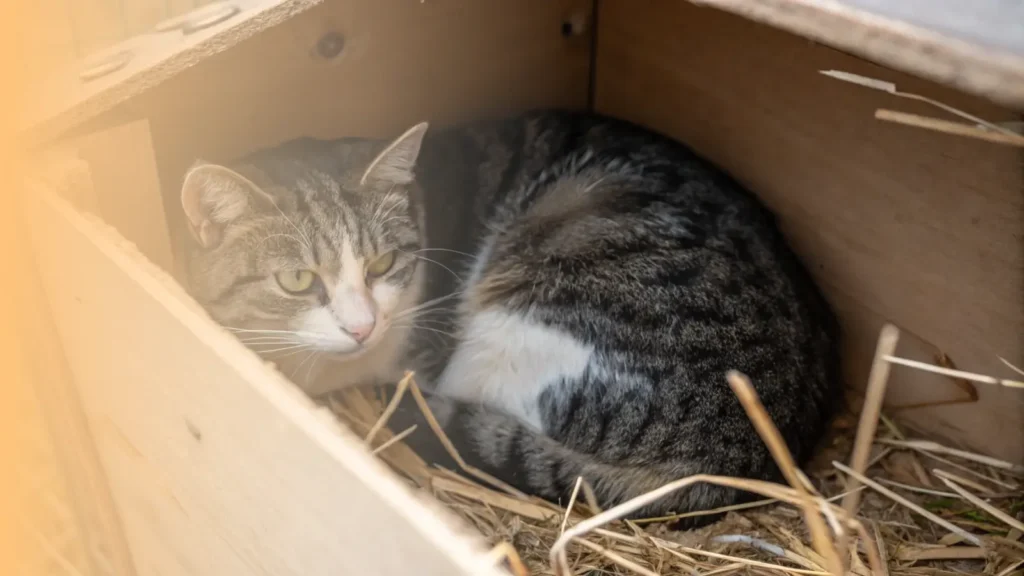The thought of new kittens arriving is usually a joyous one, but sometimes, despite our best hopes, pregnancies can face serious challenges.
Understanding the signs that a pregnant cat might have a deceased kitten inside her is so important, as it allows you to act quickly to protect her health and well-being.
Pre-Labor Signs of a Deceased Kitten
If a kitten has sadly passed away in the womb before labor is due to start, your usually vibrant and happy cat might begin to show some subtle or even more obvious changes.
It’s worth remembering that some cats, especially if the loss occurs very early in the pregnancy or if a tiny fetus becomes mummified and remains sterile inside, might not show any outward symptoms at all.
However, being observant and aware of potential clues can make all the difference in getting her timely help.
1. Changes in Appetite or Behavior
One of the first things you might notice is a sudden loss of appetite. If your normally food-motivated pregnant cat completely stops eating or drinking, it’s a common sign that something isn’t quite right.
While this can be a general indicator of illness in any cat, for an expectant mother, it always warrants a closer look and a prompt call to your vet.
You might also observe her being unusually tired, weak, perhaps a bit withdrawn, or just not her usual perky self, choosing to hide away when she’s normally sociable. These behavioral shifts, however subtle, can be her way of telling you she’s not feeling her best.
2. Unusual Vaginal Discharge
This is a really significant sign to be vigilant about. During most of a healthy pregnancy, you shouldn’t expect to see much, if any, discharge.
A very small amount of bloody or mucousy discharge can be normal right as labor is about to begin, but at other times, the following are definite red flags:
a. Bloody discharge
More than just a few incidental drops, or any persistent bloody spotting, particularly if it occurs between the second and eighth week of pregnancy, is considered abnormal and is a clear signal that she needs to be checked by your vet.
b. Foul-smelling discharge
This is a critical warning sign that requires immediate attention. If you see a discharge that has a bad, offensive odor and perhaps looks greenish, brownish, black, or obviously like pus, it strongly suggests a serious uterine infection.
This could be due to a condition called fetal maceration, where a deceased fetus begins to decompose due to bacteria.
c. Greenish discharge before any kittens are born
If you notice a greenish discharge appearing before any kittens have been delivered, this can indicate that a placenta has separated prematurely. This is an emergency for any remaining kittens as it cuts off their vital oxygen supply.
The color, smell, and consistency of any vaginal discharge can provide your veterinarian with vital clues about what might be happening inside.
3. Fever
An elevated body temperature is often a clear signal that an infection or significant inflammation is present in her body. For our feline friends, a rectal temperature over 103°F (39.4°C) is generally considered a fever.
If your pregnant cat feels unusually warm to the touch, or if you take her temperature and confirm it’s high, it’s a definite reason to contact your vet without delay.
4. Cessation of Fetal Movement
In the later stages of her pregnancy, often in the last couple of weeks, you might be lucky enough to feel or even see the gentle flutters and movements of the kittens within her belly. It’s quite a magical experience!
However, if you’ve been noticing this activity and it suddenly stops, especially if it was previously quite active and easily detected, it’s an alarming sign and could, unfortunately, mean the kittens are no longer alive.
5. Overly Long Pregnancy Without Labor
Cat pregnancies typically last between 58 to 67 days, with the average being around 63 to 65 days from mating.
If your cat goes significantly beyond this timeframe, for example, past 67 to 70 days, without showing any of the usual signs that labor is about to begin (like nesting or restlessness), it could indicate there’s a problem.
Sometimes, if the fetuses within have died, the mother’s body might not naturally receive the hormonal signals to initiate the birthing process.
6. Abdominal Discomfort
Watch for signs that her tummy might be sore. If your pregnant cat appears restless, keeps shifting her position as if she just can’t get comfortable, or seems to guard her abdomen, perhaps acting resentful if you try to touch it, it can indicate discomfort or pain that needs looking into.
Other less specific signs that something could be amiss include episodes of vomiting, a noticeable lack of interest in her usual fastidious grooming, unusual or excessive meowing as if in distress, or apparent trouble urinating or defecating.
It’s so important to be aware that some of the most dangerous underlying conditions, such as fetal maceration or a severe uterine infection like pyometra, can initially present with quite vague symptoms – perhaps she’s just a bit off her food or a little quieter than normal.
The situation can then escalate very quickly, with more alarming signs like a foul-smelling discharge appearing.
This is why taking any deviation from your pregnant cat’s normal health or behavior seriously and seeking veterinary advice promptly is always the safest and best approach.
Signs of Trouble During Labor
When labor begins, it’s an anxious but exciting time. However, if things aren’t progressing as they should, it’s called dystocia, or difficult birth, and it’s an emergency that needs immediate veterinary intervention.
If labor isn’t going smoothly, it could mean a kitten is stuck or has sadly passed away. Here are the signs to be alert for:
1. Strong, Unproductive Straining
If your queen is visibly straining hard and frequently, with strong abdominal contractions, but no kitten is produced within a reasonable timeframe – typically if this goes on for more than 20 to 30 minutes – it’s a critical concern.
While some guidelines might extend this to 60 minutes, seeking help sooner is generally much safer for both mother and kittens.
2. Long Intervals Between Kittens
Kittens are usually born every 30 to 60 minutes during the active stage of labor, though this can vary. If more than two hours pass between the birth of kittens, especially if your queen has stopped actively straining and you know or suspect there are more kittens yet to come, it’s a cause for concern. This is different from a normal “interrupted labor,” which we’ll touch on.
3. Abnormal Discharge During Labor
Keep a close eye on any discharge during the birthing process:
- Greenish or blackish discharge appearing before the first kitten is born (or between kittens, if not immediately followed by a kitten or its placenta): This can be a sign of premature placental separation and indicates the kittens are in distress. (It’s important to note that a greenish-black discharge is normal when it comes with or just after the passage of a placenta).
- Excessive bright red bleeding (more than a steady dripping that persists for more than 10 minutes): This is not normal during labor and suggests a hemorrhage, which is serious.
4. Kitten Visible but Not Progressing
If you can see a kitten, or a part of a kitten, or the fluid-filled amniotic sac (the “water bag”) at her vulva, but despite her straining efforts, the kitten is not delivered within 10 to 20 minutes, it means the kitten is likely stuck.
5. Maternal Exhaustion or Extreme Distress
Look for signs that your cat is becoming overly tired or is in severe distress. This might include her stopping straining altogether and becoming very lethargic, weak, or depressed.
Other worrying signs are excessive panting, constant crying or vocalizing as if in pain for over an hour without delivering a kitten, or appearing extremely restless. A fever developing during the birthing process is also a serious sign of trouble.
6. Retained Placentas
A placenta (often called the afterbirth) should be passed for each kitten, usually within about 15 minutes of its birth, or sometimes it might come out with the next kitten.
If you count fewer placentas than the number of kittens born, and especially if your queen subsequently seems unwell, is restless, or develops a fever or an abnormal discharge later on, one or more placentas may have been retained inside her, which can lead to a nasty infection.
It’s so important to try and differentiate normal labor from abnormal labor, though it can be tricky. Sometimes cats experience a phenomenon known as “interrupted labor,” where the queen may pause birthing, rest comfortably, nurse the kittens already born, and even eat a little, before resuming labor and delivering the remaining kittens, sometimes 12, 24, or even up to 36 hours later!
During this normal pause, she should appear calm, comfortable, and attentive to her newborns. The key difference between this normal variation and dystocia is the queen’s condition.
If she is distressed, continues to strain intermittently without success, appears weak, or shows any other signs of illness during a prolonged interval, it is not normal interrupted labor and constitutes an emergency.
Given the potential for misinterpretation, the safest course of action is always to contact your veterinarian if you have any doubt whatsoever about the progression of labor.
Seriousness of These Symptoms for the Mother Cat
The presence of a deceased kitten inside a cat, or significant complications arising during the birth, can pose very serious, even life-threatening, risks to the mother’s health.
If a deceased fetus remains within the uterus, it can unfortunately become a source of dangerous infection.
1. Metritis
This is an inflammation and infection of the uterus that can occur after pregnancy, particularly if the delivery was prolonged or difficult, or if fetal membranes (placentas) or a dead fetus are retained inside the uterus.
A bacterial infection is typically present. The primary sign you might notice is often a foul-smelling, pus-like (purulent) discharge from her vulva.
Queens suffering from metritis are usually systemically ill, showing signs such as fever, depression, lethargy, a loss of appetite, and they may neglect any surviving kittens.
2. Pyometra
This is a severe bacterial infection of the uterus characterized by the accumulation of pus within the uterine cavity.
While pyometra can develop for other hormonal reasons, the presence of retained dead fetal tissue can create an ideal environment for bacteria to multiply rapidly, potentially leading to or worsening a pyometra.
If the cat’s cervix is open (“open pyometra”), you’ll often see a noticeable vaginal discharge of pus, which might be bloody or brownish.
If the cervix is closed (“closed pyometra”), the pus accumulates within the uterus, causing her abdomen to swell, and no discharge will be visible. Cats with closed pyometra tend to become severely ill very quickly. Untreated pyometra is life-threatening.
3. Septicemia and Toxemia
These are critical, body-wide conditions where bacteria (causing septicemia) or their harmful toxins (causing toxemia) enter the bloodstream and spread throughout the cat’s body.
This triggers a massive systemic inflammatory response and can lead to organ damage. They are severe consequences of untreated uterine infections like fetal maceration, metritis, or pyometra, where the compromised uterus acts as a reservoir for these dangerous substances.
Septicemia and toxemia are veterinary emergencies with a high mortality rate if not treated aggressively and promptly.
These conditions really underscore how a problem that starts locally within the uterus, such as a retained dead fetus that becomes infected, can rapidly escalate into a systemic, life-threatening crisis for your beloved cat.
Veterinary Diagnostic Approach
When you suspect a problem with your pregnant or birthing cat and take her to the vet, they will use a systematic approach to diagnose the issue.
They will start by asking for a detailed history, including her age, breed, mating date if known, and the onset and nature of any symptoms you’ve observed.
A complete physical examination will follow, where the vet assesses her overall condition and gently palpates (feels) her abdomen.
To get a clearer picture of what’s happening inside, your vet will likely use:
1. Ultrasound
This non-invasive imaging tool is invaluable. It can confirm pregnancy, and crucially, assess fetal viability by detecting heartbeats. It helps identify signs of fetal death, mummification, or maceration, and can also evaluate the uterus for abnormalities like pyometra.
2. X-rays
Radiographs are particularly useful in the later stages of pregnancy (after about 6 weeks, when fetal skeletons have calcified).
They can help determine a more accurate count of fetuses, assess their size and position relative to the queen’s pelvis (which can identify obstructions), and can also identify skeletal remains of deceased fetuses or other signs of fetal death, such as gas within a fetus.
3. Blood tests
Blood samples are often taken to assess your cat’s overall systemic health. These tests can reveal signs of infection, anemia (low red blood cell count), dehydration, or electrolyte imbalances, and check the function of major organs, which can be affected by toxins from uterine infections.
This comprehensive diagnostic approach allows your veterinarian to build a complete picture of the situation and determine the best course of action.
Owner Actions for Warning Signs
If you notice any of these troubling symptoms in your pregnant or birthing cat, it’s a situation that demands immediate and appropriate action.
1. Act Quickly and Calmly
While it’s natural to feel anxious or distressed, try to remain as calm as possible to make clear decisions. However, it’s vital not to delay in seeking help, as time is often critical.
2. Observe and Document Symptoms
Take careful note of all specific symptoms your queen is exhibiting. When did they start? How have they progressed? What is her general demeanor? Is there any abnormal discharge (color, smell, amount)? Is she straining? For how long? Are any kittens visible? Documenting these details will be very helpful for your veterinarian.
3. Ensure a Quiet, Comfortable Environment
If she is not already in her queening box, gently move her to a quiet, warm, safe, and comfortable place away from other pets, children, and household disturbances. This is especially important if she is in labor or appears distressed.
4. Do Not Medicate or Intervene Obstetricaly
Never give any medications (human or animal) without explicit veterinary instruction, as many common medications are harmful to pregnant or sick cats.
Also, please do not attempt to manually pull a stuck kitten unless you are in an extreme emergency situation with no possible access to immediate veterinary help AND you have been specifically guided on how to do so by a veterinarian over the phone. Improper pulling can cause severe injury or even death to both the kitten and the queen.
5. Contact a Vet or Emergency Clinic Immediately
This is the most crucial step. Call your veterinarian or a nearby 24-hour emergency veterinary clinic immediately. Clearly explain the situation, the symptoms you’ve observed, and the queen’s status.
Follow their instructions precisely. It’s wise to have these contact numbers readily available well before your cat’s due date.
If your vet advises bringing your cat in, use a secure and comfortable cat carrier. If she has already delivered live kittens, they should generally be transported with her, ensuring they are kept warm.
If any fetuses, placentas, or unusual tissues have been expelled, place them in a clean plastic bag or container to bring to the veterinarian for examination, if possible.
Final Thoughts
Recognizing the often subtle signs that something might be amiss during your cat’s pregnancy or labor is so important for her safety and the wellbeing of any potential kittens.
While we all hope for a smooth and joyful birthing experience, being well-informed about potential problems empowers you to act swiftly and seek the expert veterinary help she might need, significantly improving the chances of a positive outcome even when faced with distressing circumstances.







